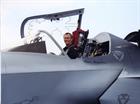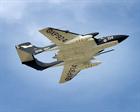Classic FAA fighter to fly over the new carrier
An historic Royal Navy 1950s fighter, the de Havilland Sea Vixen, will join the fly past over the Royal Navy’s new aircraft carrier, HMS Queen Elizabeth, at the official naming ceremony by Her Majesty The Queen in Rosyth, Scotland on Friday 4 July 2014.
Sea Vixen FAW2 (Fighter All Weather) G-CVIX XP924, painted in the colours of 899 Naval Air Squadron from HMS Eagle in 1971, is the last and only flying Sea Vixen in the world. The iconic British fighter, which flew on continuous operations throughout the 1960s and early 1970s at the height of the Cold War, is the embodiment of naval carrier aviation representing the high speed strike aircraft of ‘the jet age’ of naval fixed wing carrier operations.
This was a period of huge and demanding transition in carrier aviation capability. As aircraft became heavier and faster, new challenges arose leading to the development of innovative and revolutionary new technologies including the steam catapult, angled flight deck and mirror landing sight, all British naval aviation inventions that placed the Royal Navy and Fleet Air Arm at the forefront of technical and doctrinal development of naval carrier aviation.
The Sea Vixen FAW1 entered service with the Fleet Air Arm in 1959 replacing the Sea Venom. The first British aircraft to be armed solely with guided missiles, rockets and bombs instead of guns, Sea Vixens, flying from HMS Centaur in 1964 took part in the successful operation to restore stability in the East African state of Tanganyika. In 1961 and 1964, Sea Vixens saw service in the Persian Gulf and later in the 1960s they played a crucial role during the days of the Beira Patrol preventing oil reaching landlocked Rhodesia. In 1967 Sea Vixens also helped cover the withdrawal from Aden.
The Sea Vixen will participate in the flypast over HMS Queen Elizabeth as a result of a joint venture between the Royal Navy, the Fly Navy Heritage Trust, private enterprise and a generous benefactor, Julian Jones, through his companies, Drilling Systems UK.
“It is a fantastic combined achievement and a unique demonstration of Defence, the charitable sector and private enterprise working together to preserve the Nation’s Naval Aviation Heritage” said Commodore Bill Covington, Director of Naval Aviation Ltd.
The Sea Vixen will be flown by former Royal Navy Sea Harrier pilot, Commander Simon Hargreaves OBE, a highly experienced Royal Navy pilot and test pilot who has flown over 8,700 flying hours on 30 different aircraft types.
Simon, who saw combat in the Sea Harrier in the Falklands and the Balkans, is probably the only pilot not only to have flown all the Harrier types, including Sea Harrier, Harrier GR3, 5, 7 and 9 - but also the X-35B, the precursor to the F-35B Lightning, the new fifth generation fighter that will fly from the new carriers.
As an experimental Test Pilot with Lockheed Martin, Simon was heavily involved with the Joint Strike Fighter X-35B programme and was the first pilot to carry out a vertical take-off and landing in the aircraft.
“It is an absolute honour to be able to fly an iconic Royal Navy heritage jet aircraft over HMS Queen Elizabeth in salute to the arrival of the formidable next generation of aircraft carriers” said Simon. “The Sea Vixen, Sea Fury and Seafire symbolise the Naval Aviation Heritage story, from the earliest carrier borne aircraft through to the Phantom, Buccaneer and Harrier - and now the new F-35B Lightning! It is a powerful link between the past and the future.”





